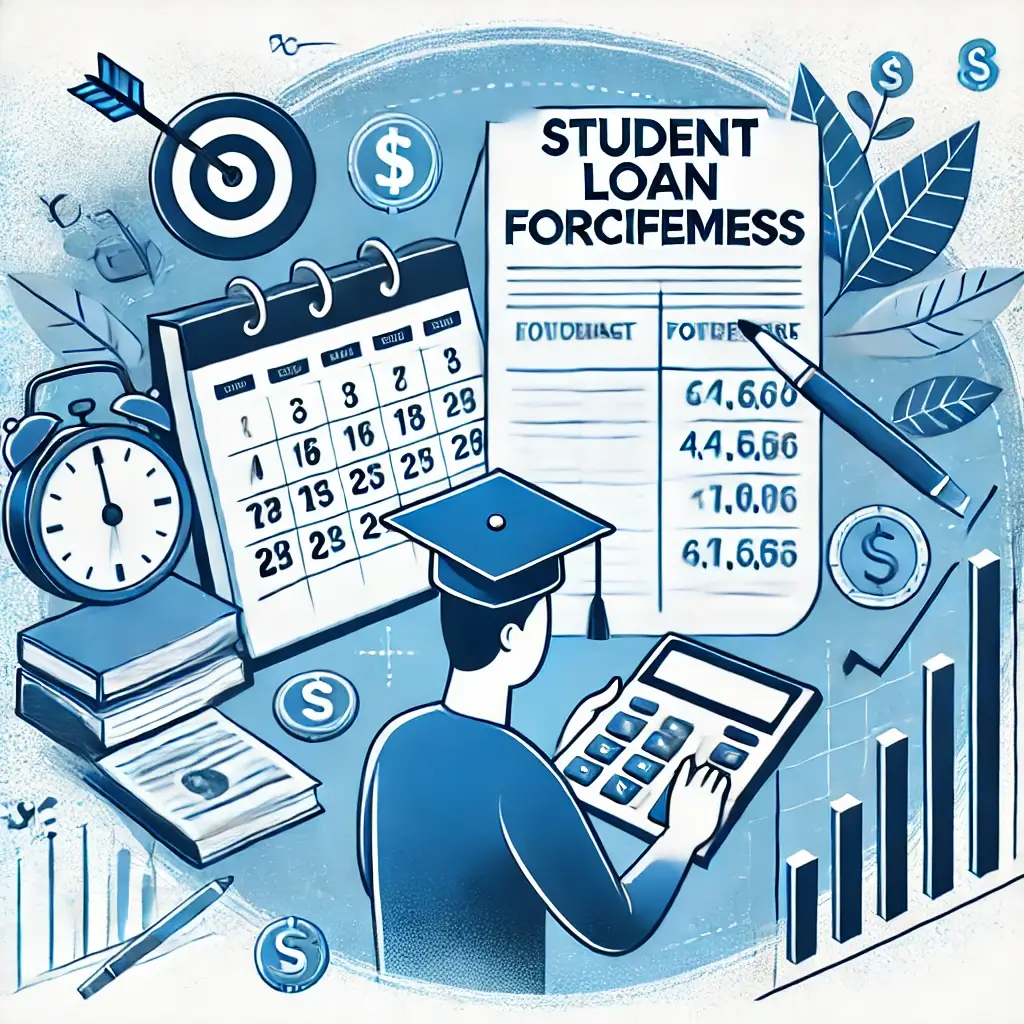Student loan debt can feel overwhelming, but student loan forgiveness programs offer a way to reduce or eliminate a significant portion of your debt. Understanding the ins and outs of these programs is key to taking advantage of the relief they provide. This Student Loan Forgiveness Programs Guide will cover the major forgiveness options, eligibility requirements, and how to apply.
1. What Is Student Loan Forgiveness?
Student loan forgiveness is a program that allows borrowers to have part or all of their federal student loan debt canceled, typically after meeting certain requirements such as working in a specific job or making payments for a set number of years. These programs are primarily available for federal loans, and they can provide substantial financial relief.
2. Types of Student Loan Forgiveness Programs
There are several major forgiveness programs available for federal student loan borrowers. Each program is designed to benefit individuals in specific career fields or repayment plans.
2.1 Public Service Loan Forgiveness (PSLF)
One of the most popular and well-known programs is Public Service Loan Forgiveness (PSLF), which forgives the remaining balance on Direct Loans for borrowers who work full-time in qualifying public service jobs.
- Eligibility: To qualify, you must work full-time for a government organization, nonprofit, or other qualifying public service employer.
- Repayment Requirement: You must make 120 qualifying monthly payments under a qualifying repayment plan (such as an income-driven repayment plan).
- Forgiveness Amount: After 120 qualifying payments (roughly 10 years), any remaining loan balance is forgiven.
2.2 Teacher Loan Forgiveness
For teachers working in low-income schools or educational service agencies, Teacher Loan Forgiveness provides up to $17,500 in forgiveness.
- Eligibility: Full-time teaching for five consecutive years in a qualifying low-income school or educational service agency.
- Forgiveness Amount: Up to $17,500 for highly qualified math, science, or special education teachers, and up to $5,000 for other eligible teachers.
- Loan Types: Direct Subsidized and Unsubsidized Loans, and in some cases, Stafford Loans.
2.3 Income-Driven Repayment Plan Forgiveness
Borrowers enrolled in an Income-Driven Repayment (IDR) Plan can have their remaining loan balance forgiven after 20 or 25 years, depending on the plan.
- Eligibility: Borrowers must be enrolled in an income-driven repayment plan, such as Income-Based Repayment (IBR), Pay As You Earn (PAYE), Revised Pay As You Earn (REPAYE), or Income-Contingent Repayment (ICR).
- Timeline: After making payments for 20 years (undergraduate loans) or 25 years (graduate loans), any remaining balance is forgiven.
- Repayment Plans: IDR plans calculate monthly payments based on income and family size, making them more manageable for borrowers with high debt-to-income ratios.
2.4 Perkins Loan Cancellation
For borrowers with Perkins Loans, Perkins Loan Cancellation offers forgiveness for individuals working in specific public service jobs, such as teaching, law enforcement, and nursing.
- Eligibility: Work in a qualifying job, such as teaching in a low-income school, law enforcement, or health care.
- Forgiveness Amount: The percentage of loan forgiveness varies based on the job and length of service, with up to 100% forgiveness after five years of service.
2.5 State-Specific Forgiveness Programs
Many states offer student loan forgiveness programs for residents working in fields such as health care, law enforcement, and teaching. Typically, these programs attract professionals to underserved areas.
- Eligibility: Varies by state and profession. Examples include the California State Loan Repayment Program for healthcare professionals and the New York State Teacher Loan Forgiveness Program for teachers.
- Forgiveness Amount: Varies by state, but often provides partial or full forgiveness for qualifying borrowers.
3. How to Qualify for Student Loan Forgiveness
Qualifying for student loan forgiveness depends on meeting the specific requirements of the program you’re targeting. Here are the key steps you need to take.
3.1 Choose the Right Loan Type
Only federal Direct Loans are eligible for most forgiveness programs, including PSLF and Teacher Loan Forgiveness. If you have FFEL or Perkins Loans, you may need to consolidate them into a Direct Consolidation Loan to become eligible.
3.2 Select a Qualifying Repayment Plan
For PSLF and IDR forgiveness, payments must be made under a qualifying repayment plan. The most common qualifying plans are income-driven repayment plans, which calculate monthly payments based on your income and family size.
3.3 Work in a Qualifying Job
To qualify for PSLF, Teacher Loan Forgiveness, or Perkins Loan Cancellation, you must work in a qualifying field. This typically includes public service, government jobs, nonprofit organizations, teaching, health care, or law enforcement.
3.4 Make the Required Number of Payments
For PSLF, you need to make 120 qualifying monthly payments while working full-time in a public service job. Concerning, Teacher Loan Forgiveness, you must work full-time for five consecutive years. For income-driven repayment, forgiveness requires an age between 20 and 25 years, depending on the plan.
3.5 Keep Detailed Records
It’s important to maintain accurate records of your loan payments, employment, and program requirements. Submit an Employment Certification Form annually for PSLF to confirm that your employment qualifies, and keep a copy of all loan payment receipts.

4. The Application Process for Student Loan Forgiveness
Applying for student loan forgiveness takes time and careful documentation. Here’s how to apply for the most common programs.
4.1 Public Service Loan Forgiveness (PSLF) Application
- Submit the PSLF Application: After making 120 qualifying payments, submit the PSLF Application for Forgiveness. You’ll also need to provide documentation of your employment history through an Employment Certification Form (ECF).
- Processing Time: It can take several months for your application to be reviewed and approved.
4.2 Teacher Loan Forgiveness Application
- Submit the Teacher Loan Forgiveness Application: After completing five consecutive years of teaching, you can apply for forgiveness. Your school or educational service agency will need to certify that you meet the eligibility criteria.
4.3 Income-Driven Repayment Forgiveness
- Automatic Forgiveness: After 20 or 25 years of making payments under an IDR plan, any remaining balance is automatically forgiven.
- Annual Recertification: You must recertify your income and family size each year to remain eligible for IDR plans.
4.4 Perkins Loan Cancellation Application
- Submit the Perkins Loan Cancellation Application: If you qualify based on your employment, you can apply for cancellation by submitting the appropriate forms to your loan servicer. Be sure to provide proof of employment.
5. The Impact of Loan Forgiveness on Your Finances
While loan forgiveness can provide significant financial relief, there are some considerations to keep in mind.
5.1 Loan Forgiveness and Taxes
In most cases, forgiveness under PSLF and Teacher Loan Forgiveness is tax-free. However, forgiveness under income-driven repayment plans may be considered taxable income, which could increase your tax liability in the year your loan is forgiven.
5.2 Financial Freedom
Receiving loan forgiveness can free up your income to pursue other financial goals, such as saving for a home, investing for retirement, or building an emergency fund. It also reduces your monthly financial obligations, giving you greater flexibility in your budget.
6. Frequently Asked Questions About Student Loan Forgiveness
6.1 Can Private Student Loans Be Forgiven?
No, private student loans are not eligible for federal forgiveness programs. Private lenders typically do not offer forgiveness options, but they may offer loan modification or forbearance in cases of financial hardship.
6.2 What Happens If I Don’t Qualify for Forgiveness?
If you don’t qualify for forgiveness, you’ll need to continue making payments according to your loan’s repayment terms. Refinancing may be an option to lower your interest rate or monthly payment.
6.3 Can I Speed Up the Forgiveness Process?
For most programs, there’s no way to speed up the forgiveness timeline. However, you can ensure you’re on track by making timely payments, recertifying your income annually, and verifying your employment status regularly.
Conclusion on Student Loan Forgiveness Programs
Student loan forgiveness programs offer a valuable way to reduce or eliminate your student loan debt, but they require careful planning and adherence to specific criteria. By understanding the available programs, following the application process, and maintaining accurate records, you can maximize your chances of having your loans forgiven. This Student Loan Forgiveness Programs Guide provides a comprehensive overview to help you navigate the complex world of loan forgiveness and achieve financial relief.
